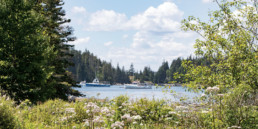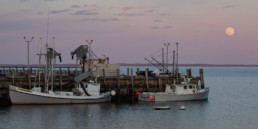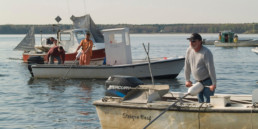The Cable Is the Key
Block Island, 13 miles south of the Rhode Island coast, is a postcard of beaches, quaint shops, and wild conservation land. With a year-round population of 1,000 residents and a summer population that can reach 10,000, it follows the seasonal ebb and flow of many New England islands. The place is small enough—10 square miles in all—that summer tourists can rent bikes and cover the entire island in a day.
As those visitors ride down Ocean Avenue on their rented bikes they can also hear a whirring reminder of what it takes to keep a remote and idyllic island in motion. Diesel generators. Block Island is connected to the mainland by a ferry service and an airport, but not an electrical cable. To keep the lights on, the Block Island Power Company imports about one million gallons of diesel each year, carried by trucks on the ferries. But a proposal from an offshore wind developer to build an offshore wind project and a cable to the mainland might change all of that.
The idea has turned into a four-year saga, with controversy on the island over altered views, and on the mainland, over the costs to ratepayers. The debate reached the highest political offices in the state and had to survive a challenge in the Rhode Island Supreme Court. But the proposal has also given the residents an opportunity to protect themselves from the expensive and unpredictable electric rates that plague many small island communities.

The company, Deepwater Wind, is proposing a five-turbine wind farm with a capacity of 30 megawatts. A submerged export cable would run from the wind project to the island. Another cable would then connect the island to the mainland. Analysts have estimated that about 10 percent of the proposed wind farm’s output would be used on Block Island. The submerged line to the mainland would be bidirectional, able to export excess offshore wind-generated electricity and import power from the existing mainland grid back to Block Island when the wind stops blowing.
“The cable is a really big piece,” said Kim Gaffett, the first warden of the town of New Shoreham, which is co-extensive with Block Island. The first warden is the town’s senior elected official. “The cable is what is going to make power for Block Island really stable and affordable, or at least more affordable than it currently is,” she said. “We’re estimating it
will cut our power cost by a third, and that’s still a high rate compared to the mainland.”
The rates fluctuate, but Block Island ratepayers can pay as much as 60 cents per kilowatt-hour, one of the highest rates in the country. By comparison, the average cost in Rhode Island is about 13 cents per kilowatt-hour. The national average is just under 10 cents per kilowatt-hour.
Deepwater Wind officials know that the cable is the key to winning local support for the project. The company is planning to run the 34.5 kV alternating-current line from a substation on Block Island to South Kingstown or Narragansett on the mainland. As an additional incentive to the islanders, the submerged line would include fiber-optics cable, delivering high-speed connections that mainland residents largely take for granted.
“There are many people for whom supporting a landmark renewable-energy project is a very important thing,” said Deepwater Wind CEO Jeffrey Grybowski. “But many folks on the island consider the cable to be the essential component of the project.” Gaffett said the cable “is a great thing for us.”
In early February of this year, the US Army Corps of Engineers closed a public comment period and reviewed more than 80 letters on the project from on and off the island. Michael Elliott, project manager for the corps, said the comments were split evenly between positive and negative sentiments.

Gaffett said that the island is mostly supportive, but she acknowledged there are some residents with misgivings. In late 2011, a poll found 62 percent of islanders in support of the project and only 27 percent opposed. “More than a majority of the people are supportive, but there is a very strong vocal opposition,” she said. “For the most part that concern is aesthetic. Those are mostly people who are not affected by the cost of electricity.”
George Mellor retired to live full-time on the island 12 years ago. His house will face the turbines. “I will be looking at it, over the ocean,” Mellor said. “I’m for wind energy in general, but this is too close. This is a pretty unique place. We don’t have stoplights. We have dirt roads. I like that. This, I think, would change that.”
Christopher Warfel, a renewable-energy engineer, was elected to the town council last November after running for office largely on the basis of his opposition to the turbine project. He urges fellow opponents to focus on the economics of the project and avoid attacking the aesthetics or the concept of offshore wind in general. “I don’t have a problem with offshore wind as a concept, but I take issue with the way it was developed,” Warfel said. “It was really forced onto Block Island and the rest of Rhode Island by the governor and the legislature.”
In 2008, the state of Rhode Island issued a request for proposals from wind energy project developers to build and operate an offshore wind farm in Rhode Island state waters south of Block Island. Research has shown the wind resource off the New England coast to be extremely valuable. State regulators chose New Jersey–based Deepwater Wind as the preferred developer.
The company initially said it would build eight turbines with a capacity of about 30 megawatts. When the German company Siemens launched a new 6-megawatt offshore wind turbine—the largest machine yet available—Deepwater reduced the number of turbines to five, but kept the overall project capacity the same.
The project is small by European standards, where the offshore wind industry is well established. It would, however, be an industry leader in the United States, which currently has no installed offshore wind turbines. The Block Island project was intended to serve, in part, as a pilot for a larger wind farm planned for federal waters much further offshore.
Donald Carcieri, Rhode Island’s governor from 2003 to 2011, praised the project and threw his political weight behind it. In December 2009 William Moore, then the CEO of Deepwater Wind, he predicted that the Block Island wind farm would be operational in 2012, perhaps even before the long-running Cape Wind offshore wind development in Massachusetts. Moore said he supported Cape Wind’s bid to develop the first offshore wind farm in the country, “but if you can’t, then we’ll be first.”
The Block Island project had undeniable momentum. On December 9, 2009, the state announced that Deepwater Wind had struck a deal to sell electricity from the project to National Grid for 24.4 cents per kilowatt-hour in the first year of operation, with a 3.5 percent annual escalation.
Three short months after Moore’s confident statement, however, Deepwater Wind hit a roadblock. On March 30, 2010, the Rhode Island Public Utilities Commission rejected the proposed power-purchase agreement as too expensive, and not “commercially reasonable.”
One expert hired by the state had told the commission that the price was inflated by excessive profits for the developer. Several analysts pointed out that the cost of the cable between the mainland and Block Island was not included in the power-purchase agreement with National Grid, and would eventually drive the cost higher.
Deepwater or another company could “be completely responsible for constructing, owning and operating the cable,” wrote Daniel Glenning, a senior project manager at National Grid, in prepared testimony to the RIPUC. “Under this option, the costs of the cable . . . would add at least $35 to $50 million to the project construction cost, to be recovered through the PPA.” RIPUC commissioner Paul Roberti was quoted in the Providence Journal, saying the decision reflected the unwillingness of mainland electric ratepayers to “pay substantially above-market prices.”
But Carcieri saw offshore wind as an economic savior for the state, where the recession was taking a heavy toll and the unemployment rate was over 11 percent. The governor and other Rhode Island political leaders would not back down. The Rhode Island legislature passed a law shortly after the RIPUC rejection that directed savings in the project to go to the ratepayers, and provided for an independent third party to verify the project’s cost. The law also effectively ordered the utilities commission to reconsider the power-purchase agreement.
In August, after a second round of review, the RIPUC approved the project. The Block Island effort is “much more than an energy project,” Carcieri was quoted as saying in 2010. “This is about creating a new industry in Rhode Island—an industry that puts Rhode Island at the epicenter of the emerging alternative-energy market.”
Although Deepwater Wind moved its corporate headquarters from Hoboken, New Jersey, to Providence, Rhode Island, the project was not out of the woods yet. Even before the commission had approved the power-purchase agreement, a group of organizations and politicians stepped forward to protest the process. One of the most ardent opponents was Rhode Island attorney general Patrick Lynch, a member of a prominent political family in the state.
“Deepwater had its chance to prove to an impartial panel, the PUC, that this deal had any merit for Rhode Islanders, and Deepwater couldn’t do it,” Lynch said, according to an account in the Providence Business News. “They had an appeal process by which they could have asked our Supreme Court to help them, and they didn’t even try to use it. It is wrong for legislation to ‘overrule’ a final judicial decision.”
Lynch was not alone. The Business News reported that TransCanada, a large onshore wind power developer, claimed that the Rhode Island law unfairly excluded out-of-state companies from meeting the state’s renewable-energy requirement. The Conservation Law Foundation, a nonprofit that usually aligns itself in favor of wind projects, protested what it saw as preferential treatment for Deepwater Wind. “The bill that created this new docket is not about renewable energy,” said CLF lawyer Jerry Elmer. “It’s a bill about helping one developer—Deepwater. CLF wants to see renewable energy done right, and that means a level playing field for all.”
When the commission approved the power-purchase agreement, it also rejected the TransCanada challenge. Lynch and the CLF immediately appealed the decision to the state’s Supreme Court. They were joined by two large manufacturers in the state, protesting the additional cost of the offshore wind electricity.
The appeals created an odd dynamic within the state government. Typically, the state attorney general defends the RIPUC’s rulings against appeals. In this situation the governor’s office was forced to find outside counsel. “The governor believes we have a responsibility to defend the constitutionality of the law. We believe the appeal is without merit,” said Amy Kempe, spokeswoman for Carcieri.
The project’s fortunes seemed to turn positive again with the 2010 elections. Lynch ran for governor but lost in the Democratic Party primaries. Democrat Peter Kilmartin was the only candidate for state attorney general who said he would drop the office’s appeal against the wind farm power-purchase agreement. Kilmartin, a former police captain, defeated the other four candidates by a wide margin.
“Although we view with trepidation the General Assembly’s unwavering quest to sink this demonstration wind farm into the sediment of Rhode Island’s continental shelf, we nonetheless are constrained by our standard of review and the bounds of the [offshore wind] statute,” the Court wrote. “In so deciding, it is this Court’s fervent hope that our Legislature’s William Seward-esque policy decision championing this amended power-purchase agreement proves as lucrative and majestic as the Alaska Purchase of 1867.”
But while the Court allowed the project to move ahead, some concerns remain. Warfel, the newly elected member of the town council, said that he fears the island could end up stuck with paying for the cable. “This project, specifically, is very expensive,” he said.
In 2008, as Rhode Island was issuing a request for proposals to offshore wind developers, officials were also launching a groundbreaking attempt to plan the use of the state’s ocean waters around offshore wind development.
The effort, known as the Special Area Management Plan (SAMP), ended up taking two years and costing $8 million. According to the SAMP website, researchers mapped fish abundance, distribution, and habitat. They also recorded where commercial, recreational, and fishing boats spend time, and identified the most valuable area of the ocean.
In July 2011, the National Oceanic and Atmospheric Administration (NOAA) approved the plan. The announcement, delivered on the shores of Narragansett Bay, drew Lincoln Chafee, the new governor, Jack Reed and Sheldon Whitehouse, the state’s two US senators, and NOAA administrator Jane Lubchenco. “By developing this plan, Rhode Island has emerged as a national leader in coastal management and ocean stewardship,” Lubchenco said, according to an NOAA press release.
Researchers developed the fishing section of the SAMP by meeting and working with the fishing community. Fishermen in the region, however, were (and are) wary of offshore wind development. “The fishing community’s opinion of the marine spatial planning process in Rhode Island is divided,” said Rick Bellavance, president of the Rhode Island Party and Charter Boat Association. He said that the fishing community is united in their belief that the final SAMP product was released prematurely. “I can say, collectively, that every fisherman feels the research that went into developing the fisheries component was inadequate,” he said. “I still think that fishermen buy into the concept of marine spatial planning, but the research needed to go further.”
Deepwater, for its part, hired a local fisherman as a liaison to the fishing community. “We have been working with him for almost a year now,” Grybowski said of the liaison. “He helps us understand their concerns and helps us deliver our message to fishermen.” Deepwater Wind also has a liaison on Block Island itself, a local citizen hired to represent the project to the residents. Grybowski said that connecting with the community and listening to local feedback has been “critically important” to the company. “Folks who didn’t support the project initially have come to support it—or at least to understand what we’re doing,” he said.
In October of 2012 the company filed its final state and federal permit applications for the project, and is hoping to begin construction in 2014. Gaffett said that the company has made outreach a priority, and “has done a really amazing job in reaching out and building local support.” She also cited the reduced risk of transporting one million gallons of diesel fuel to the island each year. But in the end, she said, it was the cable and the prospect of stabilizing local electric rates that swayed local opinion. “The cable clearly has been a major source of project support on the island,” Grybowski said.






